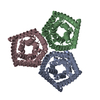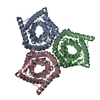+ Open data
Open data
- Basic information
Basic information
| Entry | Database: PDB / ID: 8vi3 | ||||||
|---|---|---|---|---|---|---|---|
| Title | TehA from Haemophilus influenzae purified in GDN | ||||||
 Components Components | Tellurite resistance protein TehA homolog | ||||||
 Keywords Keywords |  MEMBRANE PROTEIN / MEMBRANE PROTEIN /  ANION CHANNEL / ALPHA HELICAL INTEGRAL MEMBRANE PROTEIN ANION CHANNEL / ALPHA HELICAL INTEGRAL MEMBRANE PROTEIN | ||||||
| Function / homology |  Function and homology information Function and homology informationmonoatomic cation efflux transmembrane transporter activity / response to tellurium ion / response to antibiotic / identical protein binding /  plasma membrane plasma membraneSimilarity search - Function | ||||||
| Biological species |   Haemophilus influenzae (bacteria) Haemophilus influenzae (bacteria) | ||||||
| Method |  ELECTRON MICROSCOPY / ELECTRON MICROSCOPY /  single particle reconstruction / single particle reconstruction /  cryo EM / Resolution: 2.9 Å cryo EM / Resolution: 2.9 Å | ||||||
 Authors Authors | Catalano, C. / Senko, S. / Tran, N.L. / Lucier, K.W. / Farwell, A.C. / Silva, M.S. / Dip, P.V. / Poweleit, N. / Scapin, G. | ||||||
| Funding support | 1items
| ||||||
 Citation Citation |  Journal: Int J Mol Sci / Year: 2024 Journal: Int J Mol Sci / Year: 2024Title: High-Resolution Cryo-Electron Microscopy Structure Determination of Tellurite-Resistance Protein A via 200 kV Transmission Electron Microscopy. Authors: Nhi L Tran / Skerdi Senko / Kyle W Lucier / Ashlyn C Farwell / Sabrina M Silva / Phat V Dip / Nicole Poweleit / Giovanna Scapin / Claudio Catalano /  Abstract: Membrane proteins constitute about 20% of the human proteome and play crucial roles in cellular functions. However, a complete understanding of their structure and function is limited by their ...Membrane proteins constitute about 20% of the human proteome and play crucial roles in cellular functions. However, a complete understanding of their structure and function is limited by their hydrophobic nature, which poses significant challenges in purification and stabilization. Detergents, essential in the isolation process, risk destabilizing or altering the proteins' native conformations, thus affecting stability and functionality. This study leverages single-particle cryo-electron microscopy to elucidate the structural nuances of membrane proteins, focusing on the SLAC1 bacterial homolog from (TehA) purified with diverse detergents, including n-dodecyl β-D-maltopyranoside (DDM), glycodiosgenin (GDN), β-D-octyl-glucoside (OG), and lauryl maltose neopentyl glycol (LMNG). This research not only contributes to the understanding of membrane protein structures but also addresses detergent effects on protein purification. By showcasing that the overall structural integrity of the channel is preserved, our study underscores the intricate interplay between proteins and detergents, offering insightful implications for drug design and membrane biology. | ||||||
| History |
|
- Structure visualization
Structure visualization
| Structure viewer | Molecule:  Molmil Molmil Jmol/JSmol Jmol/JSmol |
|---|
- Downloads & links
Downloads & links
- Download
Download
| PDBx/mmCIF format |  8vi3.cif.gz 8vi3.cif.gz | 163.1 KB | Display |  PDBx/mmCIF format PDBx/mmCIF format |
|---|---|---|---|---|
| PDB format |  pdb8vi3.ent.gz pdb8vi3.ent.gz | 131 KB | Display |  PDB format PDB format |
| PDBx/mmJSON format |  8vi3.json.gz 8vi3.json.gz | Tree view |  PDBx/mmJSON format PDBx/mmJSON format | |
| Others |  Other downloads Other downloads |
-Validation report
| Arichive directory |  https://data.pdbj.org/pub/pdb/validation_reports/vi/8vi3 https://data.pdbj.org/pub/pdb/validation_reports/vi/8vi3 ftp://data.pdbj.org/pub/pdb/validation_reports/vi/8vi3 ftp://data.pdbj.org/pub/pdb/validation_reports/vi/8vi3 | HTTPS FTP |
|---|
-Related structure data
| Related structure data |  43247MC  8vi2C  8vi4C  8vi5C M: map data used to model this data C: citing same article ( |
|---|---|
| Similar structure data | Similarity search - Function & homology  F&H Search F&H Search |
- Links
Links
- Assembly
Assembly
| Deposited unit | 
|
|---|---|
| 1 |
|
- Components
Components
| #1: Protein | Mass: 35252.547 Da / Num. of mol.: 3 Source method: isolated from a genetically manipulated source Source: (gene. exp.)   Haemophilus influenzae (bacteria) / Gene: tehA, HI_0511 Haemophilus influenzae (bacteria) / Gene: tehA, HI_0511Production host:   Escherichia coli 'BL21-Gold(DE3)pLysS AG' (bacteria) Escherichia coli 'BL21-Gold(DE3)pLysS AG' (bacteria)References: UniProt: P44741 |
|---|
-Experimental details
-Experiment
| Experiment | Method:  ELECTRON MICROSCOPY ELECTRON MICROSCOPY |
|---|---|
| EM experiment | Aggregation state: PARTICLE / 3D reconstruction method:  single particle reconstruction single particle reconstruction |
- Sample preparation
Sample preparation
| Component | Name: TELLURITE RESISTANCE PROTEIN TEHA / Type: COMPLEX / Entity ID: all / Source: RECOMBINANT |
|---|---|
| Molecular weight | Value: 0.108 MDa / Experimental value: NO |
| Source (natural) | Organism:   Haemophilus influenzae (bacteria) Haemophilus influenzae (bacteria) |
| Source (recombinant) | Organism:   Escherichia coli 'BL21-Gold(DE3)pLysS AG' (bacteria) Escherichia coli 'BL21-Gold(DE3)pLysS AG' (bacteria) |
| Buffer solution | pH: 8 |
| Specimen | Conc.: 3 mg/ml / Embedding applied: NO / Shadowing applied: NO / Staining applied : NO / Vitrification applied : NO / Vitrification applied : YES : YES |
Vitrification | Instrument: FEI VITROBOT MARK IV / Cryogen name: ETHANE / Humidity: 95 % / Chamber temperature: 277.15 K |
- Electron microscopy imaging
Electron microscopy imaging
| Microscopy | Model: TFS GLACIOS |
|---|---|
| Electron gun | Electron source : :  FIELD EMISSION GUN / Accelerating voltage: 200 kV / Illumination mode: SPOT SCAN FIELD EMISSION GUN / Accelerating voltage: 200 kV / Illumination mode: SPOT SCAN |
| Electron lens | Mode: BRIGHT FIELD Bright-field microscopy / Nominal magnification: 240000 X / Nominal defocus max: 1500 nm / Nominal defocus min: 500 nm / Cs Bright-field microscopy / Nominal magnification: 240000 X / Nominal defocus max: 1500 nm / Nominal defocus min: 500 nm / Cs : 2.7 mm / C2 aperture diameter: 50 µm / Alignment procedure: COMA FREE : 2.7 mm / C2 aperture diameter: 50 µm / Alignment procedure: COMA FREE |
| Specimen holder | Cryogen: NITROGEN / Specimen holder model: FEI TITAN KRIOS AUTOGRID HOLDER |
| Image recording | Electron dose: 36.43 e/Å2 / Film or detector model: FEI FALCON IV (4k x 4k) / Num. of real images: 7352 |
- Processing
Processing
| EM software |
| ||||||||||||||||||||||||||||||||||||||||
|---|---|---|---|---|---|---|---|---|---|---|---|---|---|---|---|---|---|---|---|---|---|---|---|---|---|---|---|---|---|---|---|---|---|---|---|---|---|---|---|---|---|
CTF correction | Type: PHASE FLIPPING AND AMPLITUDE CORRECTION | ||||||||||||||||||||||||||||||||||||||||
| Particle selection | Num. of particles selected: 227571 | ||||||||||||||||||||||||||||||||||||||||
| Symmetry | Point symmetry : C3 (3 fold cyclic : C3 (3 fold cyclic ) ) | ||||||||||||||||||||||||||||||||||||||||
3D reconstruction | Resolution: 2.9 Å / Resolution method: FSC 0.143 CUT-OFF / Num. of particles: 40701 / Symmetry type: POINT | ||||||||||||||||||||||||||||||||||||||||
| Atomic model building | Protocol: RIGID BODY FIT / Space: REAL | ||||||||||||||||||||||||||||||||||||||||
| Atomic model building | PDB-ID: 3M7C Accession code: 3M7C / Source name: PDB / Type: experimental model | ||||||||||||||||||||||||||||||||||||||||
| Refine LS restraints |
|
 Movie
Movie Controller
Controller






 PDBj
PDBj
